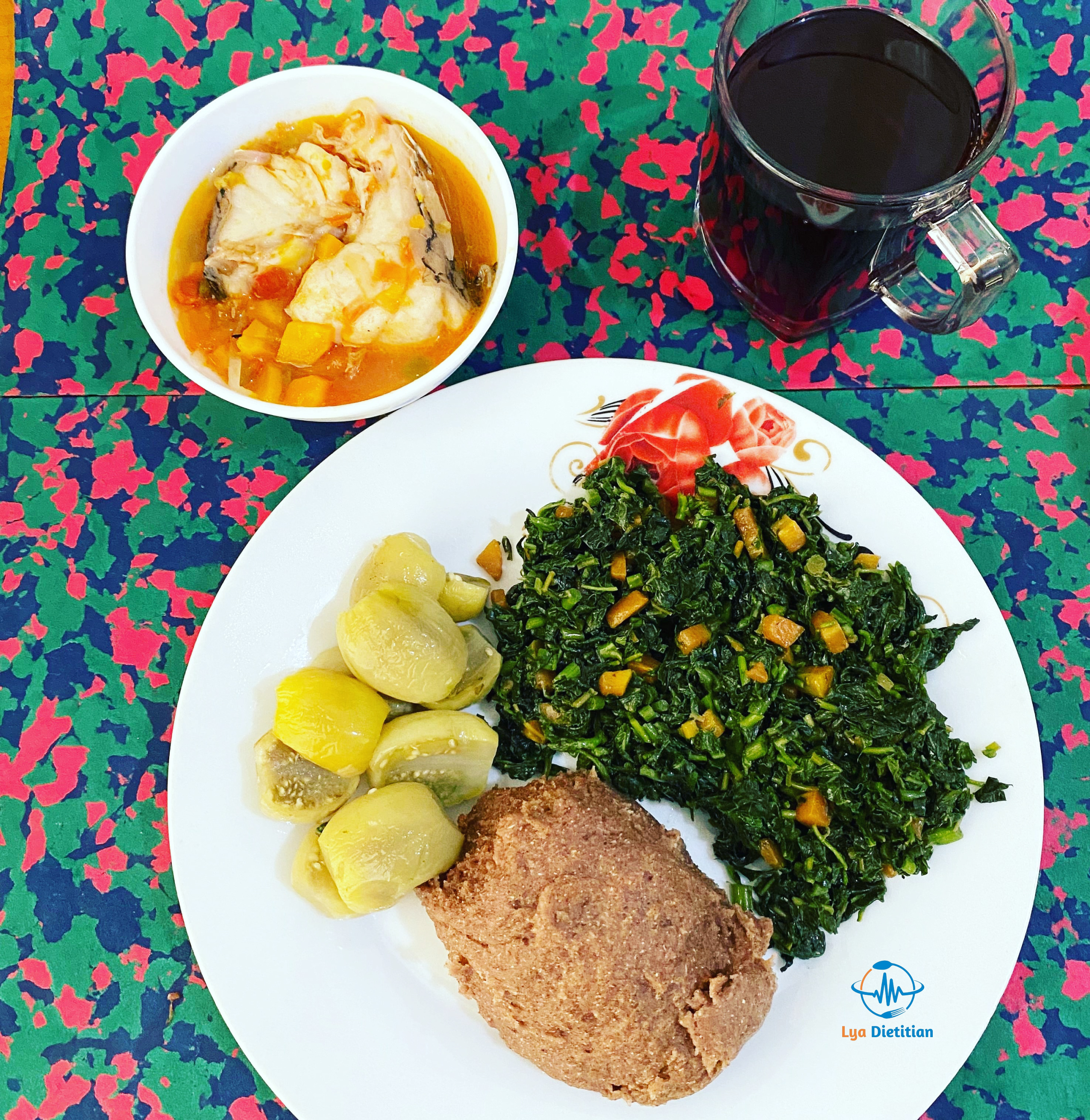Blood Glucose Control with Healthy Plate Technique

Diabetes Care Nutrition
Human beings hate restrictions and only a few will comply with the "don't eat that" approach.
I hate to hear patients say, "I can only eat a particular list of foods to control my blood sugars".
It's possible to enjoy a variety of foods while maintaining a normal blood glucose. Here is how:
Carbohydrate Counting: This focuses on only taking in a limited amount of carbohydrate. One can pick from a variety of starch or carbohydrate foods.
Eat matooke, potatoes, posho, rice, pasta, cassava, yam,maize, sorghum and millet in moderation.
What Quantity of Food?
A fist size of the listed carbohydrate rich foods is a good measure.
Two fingers of matooke equivalent to a fist size.
Choose more:
Matooke, pure millet and potatoes as these have a lower carbohydrate amount. This is the preferred choice of food.
Choose less often:
Cassava, rice and posho have more carbohydrate. Keep this in mind.
There is no need to eliminate the posho, rice, wheat and cassava however the person eating a fist of matooke will have a lower blood glucose as compared to a person eating a fist of cassava or posho.
Fruit Selection
Diabetics also need fruit in their diets as it's a source of vitamins. Fruit sugars contribute to an increase in blood glucose but should not be avoided.
Eating two to three fruits per day does not raise blood glucose levels beyond the normal range if the meals are low in carbohydrate.
However, if you have a meal with over a fist size of carbohydrate food, adding your fruit will add sugar to already high sugars causing hyperglycemia.
The fruit sugar should therefore not be avoided but caution should be taken to have healthy low carbohydrate meals ( see plate pictures).
Eat your fruit whole and not as a juice. Whole fruit has fiber that slows down the release of sugars from gut to blood.
Choose the less ripe fruit.
Vegetables with each meal are a must have as they are a source of fiber.
The higher the amount of fiber on your plate, the lower the spike in blood glucose.
Each meal should have a handful or an equivalent to a tea cup full of vegetables to provide fiber.
Maintain normal blood glucose levels after your meals
Satiety is achieved with a good food volume. Fiber adds volume to your meal without contributing to the blood glucose amount that your body will get from digesting the food.
Stop trying to fill up on starchy foods, if hungry add vegetables or a protein say beans, peas, fish, skinless chicken or lean meats. Protein foods are a good choice but not the fat on it.
Tea Choices
Taking antioxidant rich teas like hibiscus, green tea, cinnamon and rosemary contributes to a drop in blood glucose levels. A cup with each meal for best results. This tea should be unsweetened.
Other rich sources of antioxidants: Turmeric ( add to foods)
Red colored foods: tomatoes have lycopene
Green: chlorophyll in greens
The more colorful your plate, the higher the antioxidant content. However the biggest contribution to better glycemic control is a low carbohydrate diet. Don't drink tea and forget to clean eat.
IMPORTANT TO NOTE
Bloody lipid checkup: Excess fats in blood reduce insulin sensitivity. Check your blood lipids and reduce cholesterol rich foods. The antioxidants also reduce accumulation of blood fats.
Weight Loss: Obese persons find it harder to control blood glucose levels. The risk of diabetes related complications is higher when you have excess body fat.
Exercise is a must for at least 30minutes daily.
I have seen people transform their health with simple walks, light runs, rope skipping and even better results when one has a full workout routine.
Foods to Avoid
- Simple rule: Do not add the source of sugars, your body cannot handle excess sugar.
- No sugar and sugar containing foods like cakes, cookies.
- Honey is not a substitute for sugar as it continues an almost similar amount of glucose after digestion.
- Porridges, swap millet, maize porridges with pumpkin porridge or just stick to green tea and hibiscus tea for hot beverages.
- No sodas, I met a woman drinking bitter lemon soda and she said or rather believed it had no sugars since it has a bitter taste. This was sad and it partly explained the poor glycemic control over the years she has lived as a diabetic.
- No juice blends, a variety of fruits gives you a high glucose load. Worse still most of you sieve these juices and lose the fiber.
Caution: avoid hypoglycemia
A low carbohydrate diet and exercise will lower your blood glucose levels and often you are taking medication for the same purpose, having both therapies may result in very low blood glucose.
- Having a record of your blood glucose readings allows you to share with your Physician who can adjust your medical therapy.
- In case of hypoglycemia, eat a fruit or drink a sweetened beverage.
- To prevent hypoglycemia: There may be a need to eat a fruit after exercise sessions. (If truly eating the recommended amount of carbohydrate daily).
Exercise, Healthy teas and most importantly a low carbohydrate plate will have your Doctor considering a lower dose of medicines. However do not discontinue treatment on your own.
You are your own Wellness Hero so each time you eat, choose to improve health. You need to commit by keeping the end value of healthy eating in mind.
Wednesday Diabetic Care Nutrition Clinic Services:
- Learn more in a 30minute session with a Dietitian.
- Individualised Meal Plans: breakfast, lunch, dinner and snacks meal guide.
Book your first session or review with Regina Dietitian_AAR city center clinic, Uganda 0784200201
Nantege Regina
Dietitian
Comments
No comments yet. Be the first to comment!


